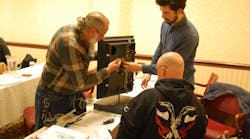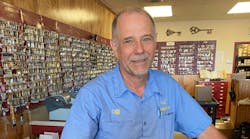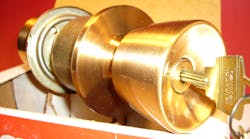A gold miner finds a single piece of gold in the rock. He’s excited about the find, but looking around he see’s nothing else of value. Does he leave the site, satisfied with his one small discovery? An experienced miner will dig deeper, looking past the obvious for the gold he knows can be found.
A locksmith is standing in front of a door opening and fixes the sticking latch he was called out for. With the latch fixed, the door once again functions and the job appears to be complete. Does he walk away from the site without digging deeper, looking at the entire opening for issues that he can address? An experienced and knowledgeable locksmith will assess the opening and other openings in the building in order to find the revenue opportunities for their business.
Revenue opportunities in healthcare market - hospitals, nursing care and especially assisted living facilities - may have been overlooked by many commercial locksmiths.
These organizations must comply with some of the most challenging requirements, codes and laws that are faced by anyone. These include:
• The Health Insurance Portability and Accountability Act of 1996 (HIPAA)
• The Americans with Disabilities Act of 1990 (ADA)
• Joint Commission on Accreditation of Healthcare Organizations (JCAHO, pronounced “jay-co”)
• The National Fire Protection Association, Life Safety Code, known as NFPA 101
Whether it be a building code or a civil rights law, a healthcare organization needs people that understand their requirements for safety and security and are able to provide solutions that address those needs. This is where the commercial locksmith can become a real partner with them by helping them meet those requirements and thereby distinguish themselves from the rest. In doing so, opportunities to “mine the opening” will present themselves... but more about that in a minute.
Let’s consider HIPAA. What does a locksmith have to do with a health insurance act? Well, HIPAA requires a healthcare provider to guard the confidentiality of protected health information (PHI). That Act has both a Privacy Rule and a Security Rule. The Security Rule is what concerns a locksmith most and where the locksmith’s expertise is vital.
Security for a room containing PHI will have many layers. The opening needs to lock, to close securely in the frame, to be able to resist forced entry and in many cases be able to control access throughout the day and provide an audit trail.
This is where you can mine the opening. Let’s say you are asked to install a lock on a door at a hospital. Asking the right question and knowing what the law requires will help you provide a solution. Ask what the room is protecting. Look at the opening. Does the door closer control the door, closing it every time and protecting people during the opening cycle? Does the frame look sound? Does it have any damage or allow easy access to the latch? Do they need to audit who has access and control when they have it?
When assessing an opening, a locksmith could provide a solid, reliable door closer and a standalone Computer Managed lock that can control access and record audits of activity (see Drawing 1 and Photo 1). Check to make sure any necessary seals are present; if not, bring that to your customer’s attention and add to your sale. Mine the opening for opportunities!
Now let’s talk about the Americans with Disabilities Act. Signed in to law on July 26, 1990, and taking effect two years later, this civil rights law has changed and in many ways re-invigorated our industry by forcing hardware manufacturers to design a new line of products to meet its many requirements.
The opportunities for the commercial locksmith to help their healthcare customer comply with this law are numerous. For starters, the most visible requirement calls for a lever handle on the door. If your customer needs a lock repaired and it’s a knob type, remind them that the ADA requires levers and why not comply with the law even though there may be an additional expense? While some customers may feel you are only trying to “upsell” them, most will appreciate your knowledge of the law and see that you are a valuable resource. (See Photo 2)
Next, check the pressure required to open the door. ADA addresses two types of opening force: interior and exterior. Meeting opening force requirements is critical to ensure that an opening is ADA compliant. Disabilities for many people may include diminished strength. Most people with disabilities can exert at least 5 lbf (pound force), both in pushing and pulling from a stationary position.
The maximum opening force requirement for an interior non-fire rated door is 5 lbs. For an exterior door the minimum opening force is allowed to be determined by the LAHJ.
ADA has no requirement for exterior doors due to environmental factors such as wind and pressure differences. Many states have set the maximum opening force at 8.5 lbs. The state of California adopted a maximum exterior opening force of 5 lbf.
How do I measure this, you ask? (See Drawing 2) Measure 30” away from the hinge or to the centerline of the trim, whichever is greater. Open the door 3” and then, using your gauge, measure the force required to get the opening to 70 degrees. You will not find these instructions on how to measure the force of a door anywhere in the ADA law. These instructions are actually taken from ANSI A156.4-4.3, the standards for door closers.
If your customer’s door closer can be adjusted to meet the ADA opening force requirements, great. If it cannot, many new products can help meet this need, including automatic operators that are not nearly as complicated and difficult to install as you might think.
The point is look for opportunities… mine the opening. This knowledge can really set you apart from your competition. If you don’t already have a gauge for this; get one!
There are many other aspects of the ADA from which the locksmith can profit, but the lever handle and an ADA compliant door closer offer the quickest path to increased sales.
The Joint Commission is something most locksmiths have never heard of but healthcare organizations have! Hospitals and other types of health care organizations are highly motivated to do well during Joint Commission surveys. Receiving or maintaining what is known as “accreditation” means that the organization is deemed by the Centers for Medicare and Medicaid Services to meet the Medicare and Medicaid certification requirements - necessary for gaining reimbursement from Medicare and managed care organizations.
In the past JCAHO would announce when they were coming and the hospital had many months to prepare. Since 2006, their surveys are unannounced. This means that the need for ongoing maintenance is greater than ever. While The Joint Commission makes no rules or codes themselves, they will check for compliance when they do their surveys and if an opening is deficient, it goes against the overall score towards accreditation.
Being aware of this, the commercial locksmith can mine the opening when they are at their customer’s site and keep them ready for that unannounced survey.
Finally we come to the Life Safety Code, NFPA 101. The Life Safety Code was originated in 1913 and his been updated and refined many times. The code seeks to address features of construction and occupancy so as to minimize the danger to life from fire, smoke, fumes or panic.
While the commercial locksmith does not need to know every provision of this code, he or she does need understand the most important requirements as they relate to any opening. Remember that sticky latch? Fixing that is good but mining the opening means you are looking for anything else that may be out of compliance. Does the door close and latch every time? Are there any devices attached to the door that would hold it open while not being controlled by the fire alarm if it’s a fire rated opening? Are there the appropriate seals around the door? Are there any holes in the door or frame?
Many of the codes and laws discussed here overlap one another. The need for a door closer is required by NFPA 101 and its opening force is regulated by the ADA. Understanding and being aware of the requirements placed on a healthcare organization will allow you to mine the opening you work on and increase not only your bottom line but your value to your customer.
Chris Clark started in the industry in 1975 as a commercial locksmith. He works for Ingersoll Rand Security Technologies in Southern California.





